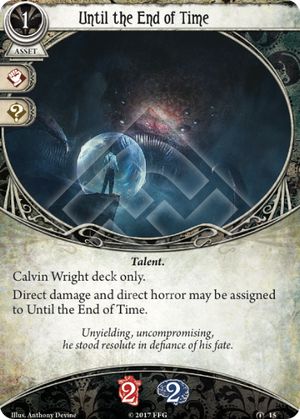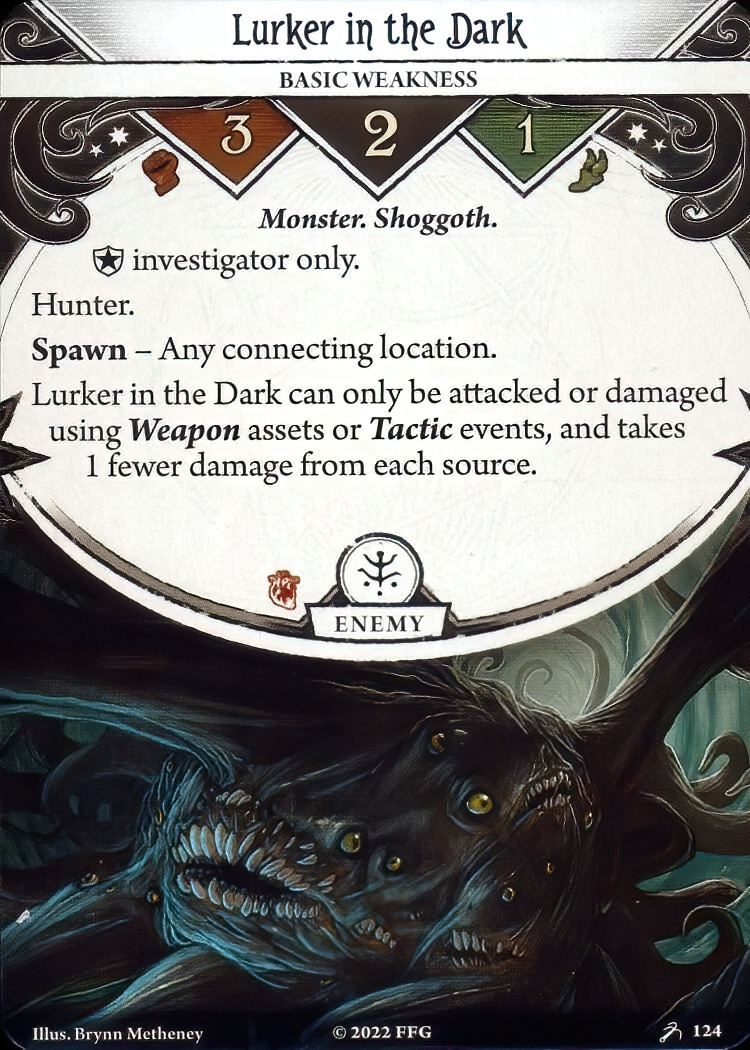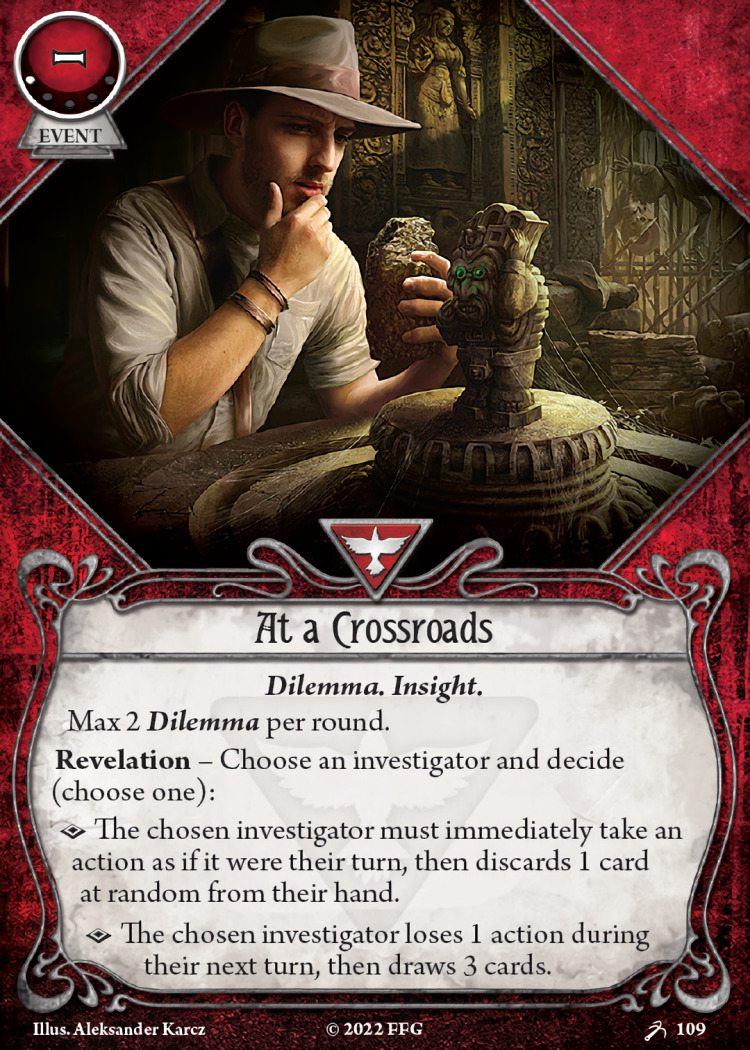
One of the absolutely worst designed weaknesses in the game by a long shot (Other honorable mention are the ones from Edge of the Earth), which is not surprising given it comes from Forgotten Age, an expansion filled with anti-player agency and some of the most anti-fun design choices I ever seen in any board game
Weaknesses are supposed to be a spanner in your wheel: they are something that will stall, cripple or potentially lead to your defeat if you are not prepared to deal with them. And even if you are prepared, they can still be a significant threat if drawn at the wrong time. And that is fine: it helps keep the tension in the game and even leads you to consider deckbuilding choices you normally wouldn't with specific investigator to counter said weakness (like using Bandages to temporaly stop Internal Injury)
That is not the case for Doomed, Doomed is literally a timed bomb attached to your back without a timer about to go off any time, and you have no way to defuse it. Take too long in camapaign and you can say good bye to your investigator and all deckbuilding progress you did.
While I do agree with many a review that do say that it fits thematically with Arkham (and that is about the only thing I appreciate about this weakness, really), and I don't blame anyone that is alright playing with it, I think design wise this weakness is beyond creatively bankrupt, given that its just a delayed instant kill. This is a game where weakness can have as various effects from simply make you discard cards and resources to more outlandish ones like draw encounter cards or have a nemesis that can block your special abilties. All of these are great! Because they make you think "How can I deal with these?", "What card can I include to counter them?" and "Can I afford to draw cards and risk getting my random basic weakness?"
Meanwhile, there is no countering for Doomed unless you can cancel the weakness' Revelation with Foresight effect or use searching to try to banish it at the bottom of the deck (usually with stuff like Scrying, Scroll of Secrets or the recent Friends in Low Places) or just try to avoid drawing as much cards as possible (which must making playing with this weakness as Mark extra fun). You are completely left at the mercy of the rng of the game whether you draw it or not in most cases, which in an already rng heavy game such as this, is not a good design choice
The effects of this weakness can be absolutely catstrophic on your campaign, not only for the effect itself, but also because of how it affect the player. Wanted to do some standalones toghether in the middle of your campaign? Forget about that, you are just gonna raise the chance to end up being killed before the end of it! It's a bit similiar to the effect of Charon's Obol in a sense: it makes you play scared, more guarded, because one mistake can be final. But while Charon's Obol's side effect can be avoided by good deckbuilding and planning, Doomed can hit you regardless of your readiness. While the Obol give you a reward for in exchange of making every defeat fatal and you can just... Not choose to pick it, Doomed, according to the rules, MUST be shuffled among your weakness if you use Forgotten Age cards and content
There is no other weakness, that I can think about, that makes you want to play less of the game: is the antithesis of fun.
But honestly, what I absolutely hate about Doomed ( and Accursed Fate) is not that they will eventually lead to The Bell Tolls. No, what I HATE with a passion about Doomed is that it is a weakass weakness on its own!
You drew this in Night of the Zealot or Dream Eaters? Congratulations, you basically got something that is arguably even less lethal than Indebted, depending on how good or bad your draw is. Even someone like Roland would look a this effect and laugh at the one horror it inflicts with his 5 sanity. It does esentially NOTHING, because the campaign will be over before this becomes a threat. That is AWFUL: a weakness should be at the very least a serious annoyance to the player, Doomed is ironically a relief in the right circumstances!
And you don't even need to draw this in a short campaign, if you luck out and avoid drawing this for half of your campaign, you are probably in the clear as well and can avoid worrying about dying from it depeding on what kind of investigator you are playing as or what scenarios are left, because most scenarios will be likely over before you could go through a deck multiple time and most investigator do not have the draw to do so anyway.
However if you are playing as someone like Harvey, Amanda or Patrice and got this card? You might as well use their superior draw to get your non-signature weakness 5 times in one scenario to spare you from the suffering of dying in 2 to 3 scenarios having already gathered and spent some exp on them
It's invevitable that some random weaknesess will be more punishing than others to some investigators (5 sanity investigators shudder seeing Chronophobia, as do 5 health ones to Internal Injury. Many a Seeker gets countered hard by Amnesia. Silas and Winifred are in for a bad time if they get The Tower • XVI, etc.), but the sheer variability of how lethal Doomed can be show just how weak its design is.
And that's what in all honesty ruins Doomed; it is too random mechanically to properly mesh with the design of Arkham. Sure sometimes it does managed to give you that sense of inevitabile demise creeping towards you, but when it fails to deliver on that, what you are left with? A good theming can only carry a card so far before that is all that it has left
And don't get me even started with the whole "campaign mode only", burn that concept with fire and impale it with prejudice! Basic wekanesses should be designed to be a threat in every scenario, because that way, no matter when they are added, they can affect your game somehow. It's signature weaknesses that can afford to have long-lasting effects (like trauma), because they are required to be added from the very start to a specific investigator deck, so they WILL affect them as long as you are playing a campaign. By the same logic, if you are playing scenario mode with specific investigators like say: Roland, Zoey and Akachi should you replace Cover Up, Smite the Wicked and Angered Spirits with other weaknesses given that trauma suffered at the end of the scenario does absolute jack in scenario mode?
Honestly what boggles my mind the most is that not only has the Return Version of Forgotten Age a better basic weakness than Doomed in Offer You Cannot Refuse, which not only has actual counter play you can engage against it, but despite being "Campaign Only" as well, it has still a nasty effect in scenario mode, given it will sap your resources regardless if you can pay your "debt" or not, meaning you can honestly still use it outside campaign mode. Even without the additional exp bonus it's WAY better designed than Doomed.
No, what leaves me speechles is that Doomed is beaten by a weakness introduced in the same box: Dark Pact is an EXCELLENTLY designed random weakness with long reaching consequences in the The Price of Failure. This is how you do basic campaign weaknesses with a nastier bonded version that will make you suffer if you cannot deal with the original weakness properly. It beats Doomed in every aspect: it's almost unreal they were designed from the same people and came from the same game.
Then again, Finn and Calvin are also from the same expansion, so I shouldn't be surprised by Forgotten Age's incredibly inconsistent design at this point



